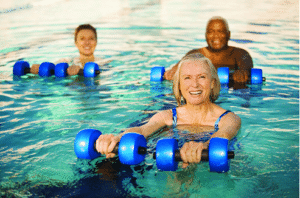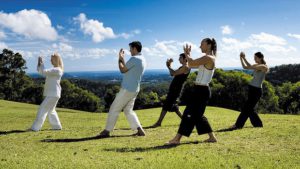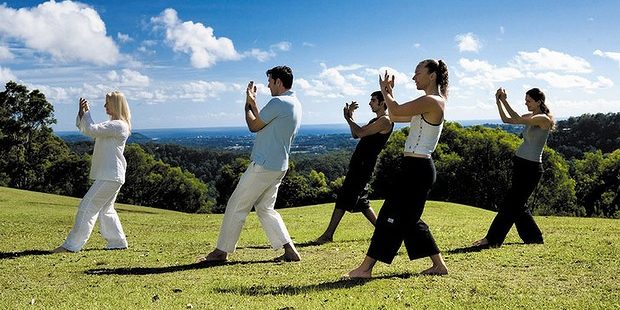Exercise is an essential part of a healthy lifestyle—it can help you to stay fit, keep cholesterol levels in check, and ward off health problems such as diabetes, heart disease, and certain forms of cancer. Not to mention, exercise is a natural mood booster that can reduce stress and alleviate symptoms of mental illnesses including anxiety and depression.
But what happens when a chronic illness—such as arthritis, fibromyalgia, high blood pressure, or cancer—makes getting regular exercise seem impossible? Medical conditions can limit your range of motion and flexibility, weaken muscles and bones, and cause debilitating pain. And those are just the physical obstacles. For people who live with pain on a daily basis, just the thought of moving—and potentially worsening pain symptoms—can be enough to trigger a wave of anxiety.

In spite of these obstacles, studies have proven time and again that exercise can help to ease chronic pain. So how can long-term sufferers capitalize on the benefits? For many, it’s about adapting the type of exercise to fit their individual limitations.
Here’s what you can do to make sure that you are getting enough exercise even when pain makes it a challenge.
See A Physiotherapist To Develop An Exercise Program
Physiotherapists work to help clients with wide-ranging mobility and pain levels stay active. Many specialize in helping people with chronic illnesses, including arthritis, to adapt their movements to lessen pain symptoms, improve their range of motion, prevent future injuries, and stay healthy and fit.
A physiotherapist can help you to design an exercise program that suits your current needs. He or she may also be able to point you towards community activities and classes designed for people with similar health constraints.
Understand Which Types of Activities Can Help You
For people who suffer from arthritis, stretching can help to tone muscles, improve flexibility and range of motion, and strengthen tendons and joints. Using light weights is another way to develop muscle strength and prevent future injuries
Aerobic activities help to improve your cardiovascular health and fitness level by getting your blood flowing. Walking and swimming are good examples of low-impact activities that can help you to maintain or improve your fitness level, even when you’re in pain. People who suffer from arthritis are often advised to avoid high-impact activities, such as soccer, jogging, playing tennis or squash, and step classes, as they can put additional strain on joints.

Moderate Exercise is Safe For Your Body
The single greatest fear that most people have when it comes to exercise is that they will injure themselves further. Research has, however, shown that this is unlikely in the case of mild to moderate exercise.
A recent research review investigated the impact of moderate exercise on knee osteoarthritis, one of the leading causes of disability in elderly adults. The researchers concluded that when trauma is avoided, moderate exercise does not contribute to the progression of the disease. In fact, exercise can help to reduce pain and disability and improve overall physical functioning. The researchers even concluded that exercise is underused as a treatment and management option for individuals suffering from osteoarthritis.
Other reviews have investigated the impact of certain types of exercise on arthritis and osteoarthritis symptoms. One such review evaluated the outcomes of clinical trials which involved tai chi interventions for people with osteoarthritis pain. Tai chi, a form of martial arts which focuses on slow, deliberate movements and deep breathing, was found to be a potentially effective method for controlling pain.

Studies have also investigated the safety of exercise-based treatments for rheumatoid arthritis, a chronic autoimmune disorder which causes inflammation, swelling, and pain in the joints and may lead to joint damage if left untreated. In one study researchers concluded that aerobic and strengthening exercises may benefit rheumatoid arthritis sufferers.
The same is true of other chronic conditions, such as chronic obstructive pulmonary disease (COPD).
Group Classes Are An Easy Way to Reap The Health Benefits of Exercise.
Depending on where you live, you might have access to group fitness classes, specifically those for people suffering from chronic health conditions. Check with your local community or recreation centre, YMCA, YWCA, or hospital to see what kind of classes they have on offer. Many offer arthritis-friendly versions of aquafit, tai chi, yoga, or dance. In addition, they may offer certain exercise programs designed for people with specific health conditions.
One example is Healthy-Steps, an exercise program designed for women who have undergone treatment for breast cancer. Also known as the Lebed Method, this program targets symptoms such as swelling in the arm and chest region, “frozen” shoulder, fatigue, and limited range of motion.
Not surprisingly, the program also attracts people who suffer from other cancers, Parkinson’s disease, and fibromyalgia, among other health conditions. Though you may be able to practice the exercises on your own, attending a class is a good way to connect with people who can sympathize with what you’re going through.

Try Adaptive Yoga
Yoga has been shown to have all kinds of important benefits for people that practice it regularly. Most facilities and studios offer classes with varying levels of difficulty. If your chronic pain symptoms are mild, a beginner or intermediate class might suit your ability. But in the case of severe pain, adaptive yoga is likely the best option.
Adaptive or chair yoga was developed by Lakshmi Voelker, a yoga teacher who wanted to help a student suffering from rheumatoid arthritis. It involves doing poses, also known as asanas while seated in a chair instead of on a mat on the floor, which helps to take pressure off the joints and ease movement. It also incorporates weights to strengthen bones and muscles.
Today, chair yoga has been applied to help people suffering from hip and knee injuries, multiple sclerosis, glaucoma, cerebral palsy, obesity, lupus, carpal tunnel syndrome, and many other conditions. It is suitable for people in wheelchairs and those confined to beds. The poses are designed to improve flexibility, balance, strength, and aerobic health, and incorporate breathing and relaxation techniques. But the poses may still require adaptation according to your health condition—for example, people with multiple sclerosis should not twist as intensely as others.
To find a chair yoga class near you, talk to your doctor or physiotherapist. You should inform your instructor of any conditions or limitations prior to the class and stop immediately if you are in pain.

Stay Active With Your Family And Around The House
People who suffer from fibromyalgia or other chronic pain conditions are encouraged to do everyday things, such as playing with their children or grandchildren, vacuuming, gardening, or going grocery shopping. Research has shown that participating in daily activities can help to improve your overall fitness level and reduce pain-related symptoms.
For many people, staying healthy is about planning for and accommodating symptoms that arise. If you tend to feel better in the mornings, schedule exercise or chores then instead of leaving them until the evening. When it comes to housework, you can use tools such as a lightweight mop or duster with an extendable handle to make the job easier. Don’t underestimate the power of a can-do attitude.
This page is also available in:
![]() Français
Français


